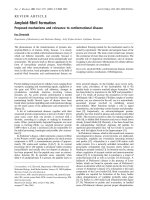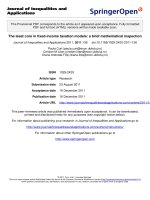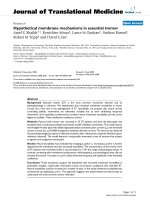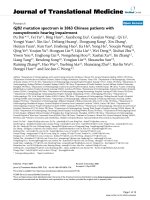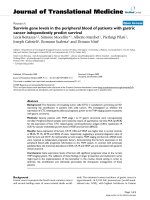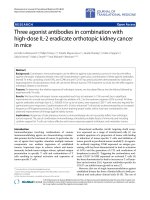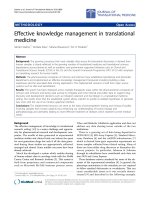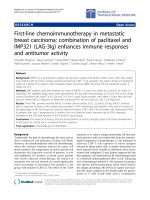Báo cáo hóa học: " Nanoparticle Network Formation in Nanostructured and Disordered Block Copolymer Matrices" doc
Bạn đang xem bản rút gọn của tài liệu. Xem và tải ngay bản đầy đủ của tài liệu tại đây (421.58 KB, 7 trang )
NANO PERSPECTIVES
Nanoparticle Network Formation in Nanostructured
and Disordered Block Copolymer Matrices
Michelle K. Gaines
•
Steven D. Smith
•
Jon Samseth
•
Saad A. Khan
•
Richard J. Spontak
Received: 23 July 2010 / Accepted: 23 August 2010 / Published online: 14 September 2010
Ó The Author(s) 2010. This article is published with open access at Springerlink.com
Abstract Incorporation of nanoparticles composed of
surface-functionalized fumed silica (FS) or native colloidal
silica (CS) into a nanostructured block copolymer yields
hybrid nanocomposites whose mechanical properties can be
tuned by nanoparticle concentration and surface chemistry.
In this work, dynamic rheology is used to probe the frequency
and thermal responses of nanocomposites composed of a
symmetric poly(styrene-b-methyl methacrylate) (SM) di-
block copolymer and varying in nanoparticle concentration
and surface functionality. At sufficiently high loading levels,
FS nanoparticle aggregates establish a load-bearing colloidal
network within the copolymer matrix. Transmission electron
microscopy images reveal the morphological characteristics
of the nanocomposites under these conditions.
Keywords Block copolymer Á Colloidal network Á
Nanostructured polymer Á Nanocomposite Á Silica Á
Nanoparticles Á Fumed silica Á Colloidal silica
Introduction
Block copolymers remain one of the most extensively
studied classes of polymers due to their innate ability to
infuse the dissimilar properties of homopolymers into a
single material by spontaneously self-organizing at the
molecular level. Molecular self-assembly is a direct con-
sequence of thermodynamic incompatibility between the
contiguous sequences comprising a block copolymer and
results in the formation of (a)periodic nanoscale mor-
phologies that can be tailored for diverse (nano)technol-
ogies [1, 2]. Ordered morphologies observed in simple
AB diblock copolymers include A(B) spheres on a body-
or face-centered cubic lattice in a B(A) matrix, A(B)
cylinders on a hexagonal lattice in a B(A) matrix, triply
periodic bicontinuous channels or alternating lamellar
sheets. Targeted addition of a selective low-molar-mass
solvent or relatively low-molecular-weight homopolymer
to an ordered block copolymer can be used to preferen-
tially swell one of the domains comprising the copolymer
nanostructure and ultimately yield tunable transitions to
morphologies with specific mechanical or spatial proper-
ties [3–8]. Recent studies have extended this general
design paradigm by modifying ordered block copolymers
with surface-functionalized inorganic nanoparticles to
achieve hybrid nanocomposites. Unlike conventional
nanocomposites prepared from homopolymers, block
copolymer nanocomposites rely on the existing copolymer
nanostructure to template—that is, spatially modulate—
the nanoparticles.
M. K. Gaines Á R. J. Spontak (&)
Department of Materials Science & Engineering, North Carolina
State University, Raleigh, NC 27695, USA
e-mail:
S. A. Khan Á R. J. Spontak
Department of Chemical & Biomolecular Engineering, North
Carolina State University, Raleigh, NC 27695, USA
S. D. Smith
Miami Valley Innovation Center, The Procter & Gamble
Company, Cincinnati, OH 45061, USA
J. Samseth
Department of Process Technology, SINTEF Materials &
Chemistry, 7465 Trondheim, Norway
J. Samseth
Akershus University College, 2001 Lillestrøm, Norway
Present Address:
M. K. Gaines
Electro-Optical Systems Laboratory, Georgia Tech Research
Institute, Atlanta, GA 30332, USA
123
Nanoscale Res Lett (2010) 5:1712–1718
DOI 10.1007/s11671-010-9775-y
Previous experimental studies [8–12] of block copolymer
nanocomposites have focused on the precise positioning of
nanoparticles within the copolymer nanostructure for use in
optics, such as waveguides. Such efforts have demonstrated
that, if sufficiently small with respect to the host copolymer
molecules (i.e., the characteristic size of the copolymer
nanostructure), nonselective nanoparticles tend to distribute
uniformly throughout the copolymer matrix in much the
same fashion as nonselective solvent molecules. Selective
nanoparticles, on the other hand, tend to locate along the
interface separating adjacent domains within the copolymer
nanostructure due to interfacial energy considerations,
which result in fewer contacts between A and B repeat units.
Larger selective nanoparticles are enthalpically driven to the
core of the compatible domains to minimize repulsive
contacts with incompatible blocks. Surface-functionalized
nanoparticles have likewise been incorporated into ordered
block copolymers to promote changes in morphology
[13–15], as well as changes in phase behavior [16–18] dis-
cerned from the order–disorder transition (ODT). We have
recently demonstrated [18] that the ODT of a poly(styrene-
b-methyl methacrylate) (SM) diblock copolymer modified
with surface-functionalized fumed silica (FS) or native
(hydroxyl-terminated) colloidal silica (CS) decreases
monotonically with increasing nanoparticle loading. If,
however, oligostyrene-functionalized CS is added to the
copolymer, the ODT increases slightly before dropping, in
qualitative agreement with self-consistent field predictions.
The objective of the present work is to examine how the
mechanical properties of such block copolymer nanocom-
posites evolve as the concentration of surface-functional-
ized FS and native CS is systematically increased. Dynamic
melt rheology is employed to investigate the mechanical
properties, and transmission electron microscopy (TEM) is
used to examine the morphology of one of the nanocom-
posites.
Experimental
The SM copolymer was synthesized via sequential living
anionic polymerization of the S block in cyclohexane at
60°C, followed by the M block in tetrahydrofuran at
-78°C, with sec-butyllithium as the initiator. According to
proton nuclear magnetic resonance (
1
H NMR) spectros-
copy and size-exclusion chromatography (SEC), the block
masses measured 13,000 each, with an overall polydis-
persity of 1.05. Three grades of functionalized FS were
obtained in powder form from Degussa Corp. (Parsippany,
NJ) and probed the effects of hydrophilicity versus
hydrophobicity and block selectivity: hydroxyl-terminated
(OH), methacrylate-terminated (MA) and octyl-terminated
(C8). According to the manufacturer, the primary particle
size in each case was *12 nm. The CS nanoparticles with
an average diameter of 10–15 nm were provided as a
suspension (20% solids) in dimethylacetamide by Nissan
Chemicals (Houston, TX). Specimens for dynamic melt
rheology were produced by ultrasonicating the nanoparti-
cles (at a specimen-specific concentration relative to the
copolymer) for 30 min in toluene to achieve a satisfactory
dispersion, followed by copolymer dissolution and further
ultrasonication, and then air- and vacuum-drying, all per-
formed at ambient temperature. No copolymer degradation
due to ultrasonication was detected according to SEC
analysis of the resultant films.
Dynamic rheology was performed on an ARES strain-
controlled rheometer equipped with serrated 8 mm parallel
plates and operated at 2% strain amplitude to ensure linear
viscoelasticity. Disks measuring 8 mm in diameter and
1 mm thick were melt-pressed at 150°C and heated to
220°C under nitrogen. Frequency (x) spectra were
acquired at discrete temperatures above and below the
ODT, while isochronal temperature sweeps were per-
formed at x = 1 rad/s and a cooling rate of 1°C/min under
a nitrogen purge to avoid oxidative degradation. Specimens
for TEMT were prepared by sectioning the glassy nano-
composites at ambient temperature. Electron-transparent
sections measuring ca. 150 nm thick were subjected to the
vapor of 0.5% RuO
4
(aq) to selectively stain the styrenic
units. Serial TEM tilt images were collected on a Gatan
UltraScan 4000 CCD camera at a resolution of 0.76 nm/
pixel and tilt angles ranging from -69° to ?69° at an
angular interval of 1.5° on a Technai T20 microscope
operated at 200 kV. While the full tilt series was aligned
using a pre-calibrated geometric model based on a high-
precision goniometer stage [19], only representative ima-
ges acquired at 0°,15° and 30° are reported herein.
Results and Discussion
According to the discontinuous change in the dynamic
storage modulus (G
0
) encountered during an isochronal
temperature sweep (upon cooling) [20], the ODT of the neat
copolymer is determined to be 186 ± 1°C (data not shown
here). Addition of FS or CS nanoparticles up to 10 wt%
reduces the ODT by as much as *7°C, depending on surface
functionality. This change in ODT is markedly different
from that observed in block copolymer nanocomposites
composed of a poly(styrene-b-isoprene) diblock copolymer
modified with C
60
buckyballs [21]. In that case, the ODT is
found by dynamic rheology to decrease by 21° C upon
incorporation of only 0.04 wt% C
60
. At higher concentra-
tions of C
60
nanoparticles (up to 0.5 wt%), the ODT does not
change further, but it does progressively broaden. Such
Nanoscale Res Lett (2010) 5:1712–1718 1713
123
sensitivity is indicative of chemical interactions between the
copolymer molecule (specifically, the unsaturated isoprenic
units) and the carbonaceous nanoparticles [22], thereby
generating a cross-linked material. Such interactions are not
expected in the present systems, although we suspect that
hydroxyl-terminated silica nanoparticles may bind with the
acrylic units upon thermal treatment. To discern the effect of
siliceous nanoparticles on mechanical properties at higher
concentrations, representative temperature sweeps are pre-
sented in Fig. 1 for SM nanocomposites containing 20 wt%
of the FS-OH, FS-C8 and CS additives.
These results immediately indicate that the fumed
nanoparticles, which exist as branched aggregates com-
monly measuring on the order of hundreds of nanometers,
have a more pronounced effect on the SM copolymer than
do CS nanoparticles. Specifically, G
0
measured for the
nanocomposites with FS consistently exceeds the dynamic
loss modulus (G
00
) over the entire temperature interval
examined, even though the copolymer exists as a struc-
tureless melt. In contrast, G
0
for the CS-containing nano-
composite increases beyond G
00
only at low temperatures.
Close examination of the data in this figure also reveals that
(1) the ODT of the copolymer in the SM/CS nanocom-
posite persists in the vicinity of 172°C, which constitutes a
14°C reduction in the ODT of the copolymer and (2) a
second, less pronounced event appears to occur in the SM/
FS nanocomposites at ca. 204°C. This second event is
absent in the neat copolymer, as well as in the system
modified with CS, whereas neither SM/FS nanocomposite
exhibits a discernible ODT. Similar disappearance of the
ODT is observed [21] in the case of nanocomposites
modified with C
60
buckyballs. Over the range from 160 to
200°C, the dynamic moduli measured from the SM-based
nanocomposites described in Fig. 1 are well behaved and
permit direct assessment of modulus enhancement as
functions of nanoparticle concentration and surface chem-
istry below and above the copolymer ODT.
The variation of the dynamic storage modulus (G
0
) and
dissipation factor (tand = G
00
/G
0
) with nanoparticle con-
centration is provided at a temperature below the virgin
copolymer ODT (at 160°C) in Fig. 2a, b, respectively, and
above the ODT (at 200°C) in Fig. 2c, d, respectively. In
Fig. 2a, values of G
0
measured from FS-containing nano-
composites generally increase slowly up to *5 wt% and
then increase sharply at higher FS concentrations. In con-
trast, G
0
from the SM/CS nanocomposite remains relatively
flat and does not exhibit an abrupt rise until 20 wt% CS,
indicating that single CS nanoparticles are less effective at
improving the rigidity of the nanocomposite at low loading
levels than the aggregated FS nanoparticles. Within the
family of FS nanoparticles examined here, the FS-MA
variant appears to be the most effective, while the FS-C8
nanoparticles are the least effective, at improving the
mechanical properties of the copolymer. This is most likely
due to the presumably nonselective nature of the FS-C8
nanoparticles. The FS-MA and FS-OH nanoparticles, on
the other hand, can preferentially interact with the PMMA
units of the copolymer and therefore immobilize the
chains. The solid and dashed lines included in the figure are
meant as guides for the eye, but correspond to exponential
regressions and fit the data surprisingly well. Similar
behavior is observed at 200°C (cf. Fig. 2c) when the
copolymer is above its ODT and disordered. It is interest-
ing that the onset of the increase in G
0
occurs at about the
same concentration of both FS and CS nanoparticles.
In Fig. 2b, tand, a direct measure of liquid- versus solid-
like behavior, is provided as a function of nanoparticle
concentration and shows that, up to the concentration
where G
0
suddenly increases in Fig. 2a, tand is, for the
most part, greater than unity. Since tand = G
00
/G
0
, this
observation indicates that the nanocomposite behaves
liquid-like. At higher nanoparticle concentrations, tand
decreases below unity, and the material behaves more
solid-like. While there is little systematic variation among
the three surface-functionalized FS grades, the SM/CS
nanocomposites exhibit the greatest liquid-like tendency,
marginally behaving solid-like at 20 wt% CS. As before,
similar results are seen in Fig. 2d, which displays tand as a
function of nanoparticle concentration at 200°C, above the
copolymer ODT. Solid-like behavior becomes evident at
nanoparticle loading levels that correspond to the sharp rise
in G
0
. The one series that deviates from the data previously
Fig. 1 Temperature dependence of the dynamic shear moduli (G
0
,
open;G
00
, filled) for SM nanocomposites containing 20 wt% of three
different nanoscale additives: hydroxyl-terminated colloidal silica
(CS, circles), hydroxyl-terminated fumed silica (FS-OH, triangles)
and octyl-terminated fumed silica (FS-C8, squares). The dotted
vertical line identifies an abrupt change in G
0
that occurs in the case of
the hydroxyl-terminated nanoparticles
1714 Nanoscale Res Lett (2010) 5:1712–1718
123
discussed with regard to Fig. 2b consists of the SM/FS-C8
nanocomposites. According to Fig. 2d, tand for this series
attains the highest tand value measured (15.5 at 0.1 wt%) in
this study and thus exhibits the greatest liquid-like behavior
of all the nanocomposites investigated. As the concentra-
tion of FS-C8 is increased, however, values of tand for this
series become comparable to those measured for the other
FS, as well as CS, series.
Of all the additives considered here, the discrete CS
nanoparticles appear to be the least effective in improving
the mechanical properties of the SM copolymer (due to the
formation of discrete, rather than interconnected, aggregate
structures) and are not considered further. The FS-C8
nanoparticles likewise appear ineffective at low nanopar-
ticle concentrations and temperatures above the copolymer
ODT, but their efficacy progressively improves as the
nanoparticle concentration increases. Since this series of
nanocomposites represents the worst case of FS-based
nanoparticles in terms of property-enhancing attributes, it
is used to probe the ability of FS nanoparticles to form
colloidal networks within the nanostructured copolymer
matrix. Figure 3a shows the frequency spectra for G
0
and
G
00
at 140°C and a nanoparticle concentration of 0.5 wt%
FS-C8. Viscoelastic behavior is observed wherein G
00
exceeds G
0
at low x, but G
0
grows larger than G
00
at high x
[23]. The crossover point at x
c
, where G
0
and G
00
intersect,
yields a characteristic relaxation time (s) for the material.
In this case, s = 1/x
c
is about 1.67 s. At 200°C, similar
behavior is observed (data not shown), but s decreases by
an order of magnitude to 0.13 s.
When the concentration of FS-C8 is increased to 10
wt%, the frequency spectra change dramatically from the
one displayed in Fig. 3a. In Fig. 3b, G
0
is greater than G
00
over the entire x range examined, although both are fre-
quency dependent. These data are reminiscent of weak gel-
like materials possessing a long relaxation time [24–27]. In
the disordered SM copolymer matrix at 200°C (Fig. 3c),
we notice a remarkable behavior: G
0
continues to exceed
G
00
, remaining parallel at high x (with G
0
and G
00
scaling as
x
0.35
) but starting to show evidence of a plateau at low x.
The presence of a low frequency plateau in G
0
suggests that
this material is more gel-like than any of the others [25,
27–29]. Interestingly, the modulus of this sample is lower
than that of the specimen portrayed in Fig. 3b. These
results taken together suggest the presence of a sample-
spanning, self-supporting network within the disordered
copolymer melt. In the ordered state, the nanocomposite
possesses a higher modulus, but an apparently weaker FS
network (due possibly to network disruption upon
copolymer ordering). Since this is the least effective
modifier of the FS family, it immediately follows that the
other additives exhibit comparable, if not more pro-
nounced, network behavior at nanoparticle concentrations
of 10 wt% or more.
Fig. 2 Dependence of G
0
(a,c) and tand (b,d)on
nanoparticle concentration for
four nanoparticle species—CS
(filled circle), FS-OH (open
triangle), FS-C8 (open square)
and FS-MA (open circle)—at
two temperatures (in °C): 160
(a,b) and 200 (c,d). The solid
and dashed lines serve as guides
for the eye for the FS-MA and
CS data, respectively; whereas
the shaded region shows the
range in G
0
over which
nanoparticle concentration
generally has little effect on
nanocomposite mechanical
properties. The vertical dotted
line identifies the concentration
vicinity beyond which the
nanocomposites behave solid-
like, and the horizontal dotted
line (c,d only) signifies where
tand = 1
Nanoscale Res Lett (2010) 5:1712–1718 1715
123
We now turn our attention to the most promising net-
work-forming nanoparticle grade: FS-MA. Conventional
TEM images acquired from relatively thick stained sec-
tions of two nanocomposites containing 5 and 20 wt%
FS-MA are provided at 0°,15° and 30° tilt in the top
and bottom rows, respectively, of Fig. 4. In the case of
the material with 5 wt% FS-MA, the lamellar morphology
of the SM copolymer is evident and possesses a period
of 20 ± 2 nm. Existence of lamellae confirms that the
copolymer molecules are capable of self-organizing (albeit
under frustrating conditions) and that an ODT should be
observed, which it is according to dynamic rheology [18].
Discrete clusters of FS-MA nanoparticles are likewise
visible and measure from *10 to 35 nm across (which is
on the same scale as the primary FS-MA nanoparticles).
Recall that, of all the FS nanoparticles investigated here,
the FS-MA nanoparticles are expected to be the most
uniformly dispersed throughout the copolymer matrix,
because they promote the greatest and most consistent
property enhancement. Since the nanoparticles reside
throughout the specimen and TEM images provide 2D
projections of 3D objects, the precise effect of these
nanoparticles/clusters on copolymer nanostructure cannot
be directly assessed without the use of transmission elec-
tron microtomography [30, 31], which will be provided in a
forthcoming publication.
It is apparent, however, from the tilt images corre-
sponding to the nanocomposite with 5 wt% FS-MA that the
copolymer lamellae are not highly oriented due, in large
part, to the presence of the nanoparticles. Moreover, in
several locations throughout the field of view, the lamellae
appear distorted or even discontinuous (cf. the circled
region at 30° tilt), which is consistent with our previous
phase study [18] indicating that the stability of the
copolymer nanostructure (discerned from the magnitude of
the ODT) in this nanocomposite is lower than that of the
neat copolymer. In the case of the nanocomposite con-
taining 20 wt% FS-MA, however, the lamellar nanostruc-
ture of the copolymer is altogether eliminated, replaced by
a continuous background of nearly constant optical density,
whereas the FS-MA nanoparticles form a continuous net-
work that extends throughout the material. These results
agree with our findings from dynamic rheology: (1) no
ODT is discernible from isochronal temperature sweeps of
this nanocomposite and (2) this nanocomposite exhibits
solid-like behavior both at low and high temperatures in the
melt. Thus, we provide experimental evidence to demon-
strate that incorporation of nanoparticles in block copoly-
mer melts can induce sufficient molecular frustration via
nanoscale confinement to completely thwart the ability of
the copolymer molecules to form a periodic nanostructure.
Conclusions
Addition of native and surface-functionalized siliceous
nanoparticles varying in hydrophobicity and inherent
aggregation to a nanostructured block copolymer melt has
little effect on the rheological properties at low nanoparticle
concentrations, but promotes an abrupt increase in G
0
and a
corresponding decrease in tand (below unity) at high
nanoparticle loading levels. In this latter regime, the
Fig. 3 Isothermal frequency spectra acquired for G
0
(open circle) and
G
00
(filled circle) at the following conditions: a 0.5 wt% FS-C8 at
140°C, b 10 wt% FS-C8 at 140°C and c 10 wt% FS-C8 at 200°C
1716 Nanoscale Res Lett (2010) 5:1712–1718
123
nanocomposite melt behaves solid-like at temperatures
above and below the copolymer ODT, suggesting that a
colloidal network composed of nanoparticles develops.
Existence of such a network is confirmed from mechanical
frequency spectra acquired at different nanoparticle con-
centrations and temperatures. Transmission electron
microscopy provides direct visual evidence of a clustered
nanoparticle network [32] within the ordered copolymer
nanostructure and establishes that two dissimilar nano-
structures, both capable of imparting solid-like behavior to
soft materials, can coexist in block copolymer nanocom-
posite melts [33].
Acknowledgments This work was supported by the Research
Council of Norway under the NANOMAT Program. M. K. G.
expresses her gratitude for a GEM Fellowship and a NOBCChE
Procter & Gamble Fellowship.
Open Access This article is distributed under the terms of the
Creative Commons Attribution Noncommercial License which per-
mits any noncommercial use, distribution, and reproduction in any
medium, provided the original author(s) and source are credited.
References
1. I.W. Hamley, The Physics of Block Copolymers (Oxford
University Press, New York, 1998)
2. M. Lazzari, G. Liu, S. Lecommandoux (eds.), Block Copolymers
in Nanoscience (Wiley, Weinheim, 2006)
3. P. Alexandridis, B. Lindman, Amphiphilic Block Copolymers:
Self-Assembly and Applications (Elsevier, Amsterdam, 2000)
4. P. Alexandridis, R.J. Spontak, Curr. Opin. Colloid Interface Sci 4,
130 (1999)
5. T.P. Lodge, B. Pudil, K.J. Hanley, Macromolecules 35, 4707
(2002)
6. R.J. Spontak, N.P. Patel, in Developments in Block Copolymer
Science and Technology, ed. by I.W. Hamley (Wiley, New York,
2004), pp. 159–212
7. I.W. Hamley, Block Copolymers in Solution: Fundamentals and
Applications (Wiley: Hoboken, NJ, 2005)
8. R.J. Spontak, R. Shankar, M.K. Bowman, A.S. Krishnan, M.W.
Hamersky, J. Samseth, M.R. Bockstaller, K.Ø. Rasmussen, Nano
Lett. 6, 2115 (2006)
9. K. Tsutsumi, Y. Funaki, Y. Hirokawa, T. Hashimoto, Langmuir
15, 5200 (1999)
10. M.R. Bockstaller, Y. Lapetnikov, S. Margel, E.L. Thomas, J. Am.
Chem. Soc. 125, 5276 (2003)
11. M.R. Bockstaller, E.L. Thomas, Phys. Rev. Lett. 93, 166106
(2004)
12. M.R. Bockstaller, R.A. Mickiewicz, E.L. Thomas, Adv. Mater.
17, 1331 (2005)
13. C T. Lo, B. Lee, V.G. Pol, N.L. Dietz Rago, S. Seifert,
R.E. Winans, P. Thiyagarajan, Macromolecules 40, 8302 (2007)
14. B.J. Kim, J.J. Chiu, G.R. Yi, D.J. Pine, E.J. Kramer, Adv. Mater.
17, 2618 (2005)
15. B.J. Kim, G.H. Fredrickson, C.J. Hawker, E.J. Kramer, Langmuir
23, 7804 (2007)
16. K.M. Lee, C.D. Han, Macromolecules 36, 804 (2003)
17. A. Jain, J.S. Gutmann, C.B.W. Garcia, Y. Zhang, M.W. Tate,
S.M. Gruner, U. Wiesner, Macromolecules 35, 4862 (2002)
18. M.K. Gaines, S.D. Smith, J. Samseth, M.R. Bockstaller,
R.B. Thompson, K.Ø. Rasmussen, R.J. Spontak, Soft Matter 4,
1609 (2008)
19. Q.X.S. Zheng, M.B. Braunfeld, J.W. Sedat, D.A. Agard, J. Struct.
Biol. 147, 91 (2004)
20. J.H. Rosedale, F.S. Bates, Macromolecules 23, 2329 (1990)
21. Y. Zhao, T. Hashimoto, J.F. Douglas, J. Chem. Phys. 130, 124901
(2009)
22. A. Laiho, R.H.A. Ras, S. Valkama, J. Ruokolainen, R. O
¨
sterba-
cka, O. Ikkala, Macromolecules 39, 7648 (2006)
23. J.M. Dealy, R.G. Larson, Structure and Rheology of Molten
Polymers: From Structure to Flow Behavior and Back Again
(Hanser, Munich, 2006)
24. R.J. English, S.R. Raghavan, R.D. Jenkins, S.A. Khan, J. Rheol.
43, 1175 (1999)
Fig. 4 TEM images acquired at
three different tilt angles
(labeled) from SM/FS-MA
nanocomposites containing 5
and 20 wt% FS-MA (top and
bottom rows, respectively). In
each case, the FS-MA
nanoparticles appear as
electron-opaque (dark)
aggregate features, whereas the
styrenic lamellae of the SM
copolymer are likewise dark due
to selective staining. The arrow
shows the location of lamellae
comprising the copolymer
nanostructure, whereas the
circled region highlights
copolymer lamellae that appear
distorted or partially
discontinuous
Nanoscale Res Lett (2010) 5:1712–1718 1717
123
25. A. Tayal, V.B. Pai, S.A. Khan, Macromolecules 32, 5567 (1999)
26. B.S. Chiou, S.R. Raghavan, S.A. Khan, Macromolecules 34, 4526
(2001)
27. R. Kumar, G.C. Kalur, L. Ziserman, S.R. Raghavan, Langmuir
23, 12849 (2007)
28. R.J. English, J.H. Laurer, R.J. Spontak, S.A. Khan, Ind. Eng.
Chem. Res. 41, 6425 (2002)
29. V.B. Pai, S.A. Khan, Carbohydr. Polym. 49, 207 (2002)
30. H. Jinnai, R. J. Spontak, T. Nishi, Macromolecules 43, 1675 (2010)
31. V. Abetz, R.J. Spontak, Y. Talmon, in Macromolecular Engi-
neering Precise Synthesis, Materials Properties, Applications,
vol. 3, ed. by K. Matyjaszewski, Y. Gnanou, L. Leibler (Wiley,
Weinheim, (2007)), pp. 1649–1685
32. A.J. Rahedi, J.F. Douglas, F.W. Starr, J. Chem. Phys. 128,
024902 (2008)
33. R.B. Thompson, V.V. Ginzburg, M.W. Matsen, A.C. Balazs,
Science 292, 2469 (2001)
1718 Nanoscale Res Lett (2010) 5:1712–1718
123
